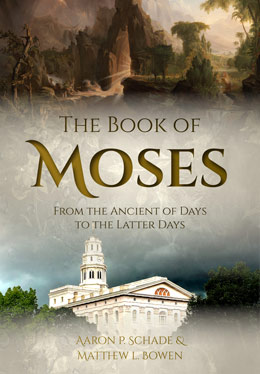Preface
The purpose of this book is to explore the ancient origins and teachings of the Book of Moses and its influence on ancient and modern audiences. As ancient scripture, the Book of Moses offers unique glimpses into God’s workings in the past. As a revealed text coming forth in modern times, it offers insights into, and opportunities of application for, God’s workings in the present. Beyond that, the teachings, doctrines, and principles found within the pages of the Book of Moses link the past with the present and future (hence the title of the volume: The Book of Moses: From the Ancient of Days to the Latter Days). From creation to Adam and Eve, the Garden of Eden to the earth’s millennial paradisiacal glory, Enoch and Zion of old to Zion and the New Jerusalem in the present and future, Noah and the flood of water to the coming of Christ with fire, and Moses and the tabernacle to Joseph Smith and latter-day temples, the Book of Moses gives us a view of the foundation on which ancient and modern societies have sought to commune with God.
Throughout this book we have endeavored to keep our commentary and interpretations informed by and in harmony with the doctrines revealed by the Lord to the Prophet Joseph Smith and with the doctrines in the Book of Moses. Together they reveal an ancient gospel consistent with its modern, restored counterpart not only in doctrine but also in practice and all other essentials. In quoting extensively from the scriptures and The Joseph Smith Papers, we provide insights that emerge from the perspectives of God and his prophets. Their voices should be heard, and their story is best told in their own words as we have them. We have thus tried to provide the ancient framework through which revelations contained in the book of Genesis are presented in the Book of Moses. Since these books share significant corresponding material, scholarly and prophetic interpretations of Genesis will be guiding pillars in our quest to uncover the ancient nuances of these two texts. We have drawn on linguistic data for insights into the meanings and contexts of the texts’ original setting. In addition, numerous interpretations that came through the revelations given to the Prophet Joseph Smith are discussed, showing the profound effect ancient scripture had on the development of the restored Church of Jesus Christ and its temples and practices.
Although writing this volume with both lay and academic audiences in mind has presented challenges, our hope is that readers of either inclination will not feel underserved. We believe the Book of Moses requires both approaches if readers are to better understand its ancient character and timeless messages.
The Prophet Joseph Smith came to understand the academic side of approaching ancient scripture. Throughout those endeavors, he never overlooked that revelation from God—ancient and modern—provided the ultimate source of truth and that it was God who spoke to him with his own voice, an act that constituted Joseph’s prophetic authority. It is Joseph’s recognition of God as the source of understanding the ancient past and the glories of eternity that makes the ongoing Restoration so remarkable. That source was an omniscient God who is not subject to the limitations imposed by human understanding. Joseph respected academic inquiry, but academia did not (and does not) always respect him. This book draws on world-renowned scholarship on the book of Genesis because scholarly sources have so much to offer in understanding the language and context of the ancient past and its scripture. However, we recognize the limitations inherent in scholarship that undertakes to reconstruct the ancient past. Accordingly, we have gained in this project a greater appreciation for all that God has revealed, all that he does now reveal, and all that he will yet reveal (see Articles of Faith 1:9). The Prophet Joseph Smith embodies the description “prophet, seer, and revelator” in ways we may not fully understand. The work the Lord performed through him—the revelations, the temple building, the doctrines, the covenants, the recovery of ancient scripture—has helped us better understand the Book of Moses as a pearl of great price proceeding from the time of Adam, the Ancient of Days, and generations forward and brought forth to us in the latter days.
Because the scope of this volume has taken us into numerous fields of studies, from the ancient world to nineteenth-century America, we would like to express sincere appreciation to our colleagues Steven C. Harper, Kerry Muhlestein, and Michael Hubbard MacKay, who read through various drafts and chapters of the present work and offered invaluable suggestions and advice that have improved its quality. We also thank our student research assistants at Brigham Young University for all their helpful readings and comments and for working tirelessly to bring this volume to fruition. To our student workers (notably Jane Stephens, Mandy Jewell, and Claire Owens) we express gratitude for their hard work and research that helped make this effort possible. We are also indebted to the painstaking care of the editors and staff at the Religious Studies Center who worked so diligently with us in the preparation of this manuscript. Lastly, and certainly not least, we would like to express deep gratitude to our spouses, Karla Bertram Schade and Suzanne Blattberg Bowen, and our families for uncounted sacrifices and support.
